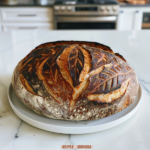This Sourdough Batard is a beautifully scored artisan loaf with a deep golden crust and a tender, tangy crumb. Naturally leavened with wild yeast, this batard-style sourdough delivers both rustic charm and refined structure—ideal for slicing, toasting, or enjoying fresh with butter.
Why You’ll Love This Recipe
The sourdough batard combines old-world technique with modern aesthetics. It’s slow-fermented for rich flavor and complex texture, making it both digestible and satisfying. The oval shape and decorative leaf scoring give it a bakery-quality look, while the crisp crust and airy interior promise artisan results in your home kitchen.
Ingredients
(Tip: You can find the complete list of ingredients and their measurements in the recipe card below.)
- bread flour
- active sourdough starter (fed and bubbly)
- water (room temperature)
- sea salt
- rice flour (for dusting)
Directions
- In a large mixing bowl, combine the active sourdough starter and water. Stir until the starter is mostly dissolved.
- Add bread flour and mix until a shaggy dough forms with no dry flour remaining. Cover and let rest for 1 hour (autolyse).
- Sprinkle salt evenly over the dough and knead gently by hand until fully incorporated.
- Perform 3 to 4 sets of stretch and folds over the next 3 hours. Cover and let the dough rest between each set.
- Allow the dough to rise until it increases by approximately 50% in volume (bulk fermentation), about 4–6 hours depending on room temperature.
- Turn the dough out onto a lightly floured surface. Gently shape it into a batard (oval loaf).
- Place the shaped dough seam-side up in a floured banneton or a towel-lined bowl. Cover and refrigerate overnight (8–12 hours).
- The next day, preheat your oven to 475°F (245°C) with a Dutch oven inside.
- Flip the dough onto parchment paper, score the top in a leaf pattern using a sharp blade.
- Carefully transfer the dough to the preheated Dutch oven. Bake covered for 20 minutes.
- Remove the lid and continue baking uncovered for 20–25 minutes, or until the crust is deep golden and crisp.
- Transfer to a wire rack and allow to cool completely before slicing.
Servings and Timing
Servings: 12 slices
Prep Time: 1 hour (active)
Cooking Time: 45 minutes
Total Time: 13–18 hours (including fermentation)
Calories per serving: Approximately 160 kcal
Variations
- Whole Wheat Option: Replace up to 25% of the bread flour with whole wheat flour for added depth and nutrition.
- Seeded Crust: Roll the shaped dough in sesame, flax, or poppy seeds before the final proof for added texture.
- Olive and Herb: Fold in chopped olives and rosemary during the stretch and fold phase for a savory twist.
- Sourdough Baguette: Shape the dough into long baguettes for thinner, crustier loaves.
- Sweet Crust: Add a touch of malt syrup or honey to the dough for a subtly sweet note and caramelized crust.
Storage/Reheating
Store the cooled loaf at room temperature in a bread bag or wrapped in a clean towel for up to 3 days. For longer storage, slice and freeze the bread in a sealed freezer bag.
To reheat, toast individual slices or warm the whole loaf in a 325°F (160°C) oven for 10–15 minutes.
FAQs
What is a batard?
A batard is an oval-shaped French loaf similar to a baguette but shorter and wider, often used in artisan baking.
Can I use all-purpose flour instead of bread flour?
Bread flour is preferred for its higher protein content, which gives the loaf structure. However, all-purpose flour can be used with slightly reduced water.
How do I know when the dough is ready to shape?
The dough should be smooth, elastic, and about 50% larger in volume after bulk fermentation. It should jiggle slightly when shaken.
What is the purpose of the overnight fermentation?
Cold fermentation in the refrigerator slows down the yeast activity, enhancing flavor and improving the crust’s texture.
Do I need a banneton?
While a banneton helps shape the dough and wick away moisture, a bowl lined with a floured towel is a suitable alternative.
Why use rice flour for dusting?
Rice flour doesn’t absorb moisture like wheat flour, making it ideal for dusting bannetons and preventing sticking.
Can I bake without a Dutch oven?
Yes, but the crust may not be as crisp. Use a baking stone and add steam to your oven by placing a pan of hot water on the lower rack.
How do I get an open crumb?
Ensure proper gluten development with gentle stretch and folds, and avoid degassing the dough during shaping.
What if my starter is not rising well?
Feed your starter regularly and ensure it is active and bubbly before use. Use it at peak fermentation (typically 4–6 hours after feeding).
How do I slice the bread without crushing it?
Let the loaf cool completely before slicing, and use a serrated bread knife for clean, even cuts.
Conclusion
This Sourdough Batard is a rewarding baking project that offers both aesthetic appeal and excellent flavor. With a crisp crust, tender crumb, and elegant scoring, it’s a loaf you’ll be proud to serve and enjoy. Whether paired with soups, cheeses, or enjoyed simply with butter, this artisan bread is a standout addition to any table.

Sourdough Batard
- Prep Time: 1 hour (active)
- Cook Time: 45 minutes
- Total Time: 13–18 hours (including fermentation)
- Yield: 12 slices 1x
- Category: Bread
- Method: Baking
- Cuisine: Artisan
- Diet: Vegan
Description
A crusty artisan sourdough batard with a tangy, chewy crumb and a beautiful leaf-scored pattern. Naturally leavened with wild yeast for depth of flavor and texture.
Ingredients
- 500g bread flour
- 100g active sourdough starter (fed and bubbly)
- 350g water (room temperature)
- 10g sea salt
- Rice flour for dusting
Instructions
- In a large bowl, mix the sourdough starter with water until mostly dissolved. Add the bread flour and stir until no dry bits remain. Cover and let rest (autolyse) for 1 hour.
- Sprinkle the salt over the dough and knead gently to incorporate.
- Perform 3–4 sets of stretch and folds over the next 3 hours, resting covered between each set.
- Let the dough rise (bulk fermentation) at room temperature until it has expanded by about 50%, 4–6 hours depending on ambient temperature.
- Turn the dough onto a lightly floured surface. Shape into a batard (oval loaf) and place seam-side up in a floured banneton or towel-lined bowl.
- Cover and refrigerate overnight for 8–12 hours.
- Preheat oven to 475°F (245°C) with a Dutch oven inside.
- Flip the dough onto parchment, score with a sharp blade in a leaf pattern, and transfer into the hot Dutch oven.
- Bake covered for 20 minutes, then uncover and bake another 20–25 minutes until golden and crisp.
- Cool completely on a wire rack before slicing.
Notes
- Ensure your sourdough starter is active and bubbly before use.
- Use rice flour for dusting to prevent sticking and give a rustic finish.
- Leaf scoring adds visual appeal and helps control oven spring.
- Resting overnight in the fridge improves flavor and crust structure.
Nutrition
- Serving Size: 1 slice
- Calories: 160 kcal
- Sugar: 0g
- Sodium: 170mg
- Fat: 0g
- Saturated Fat: 0g
- Unsaturated Fat: 0g
- Trans Fat: 0g
- Carbohydrates: 33g
- Fiber: 1g
- Protein: 5g
- Cholesterol: 0mg



Your email address will not be published. Required fields are marked *